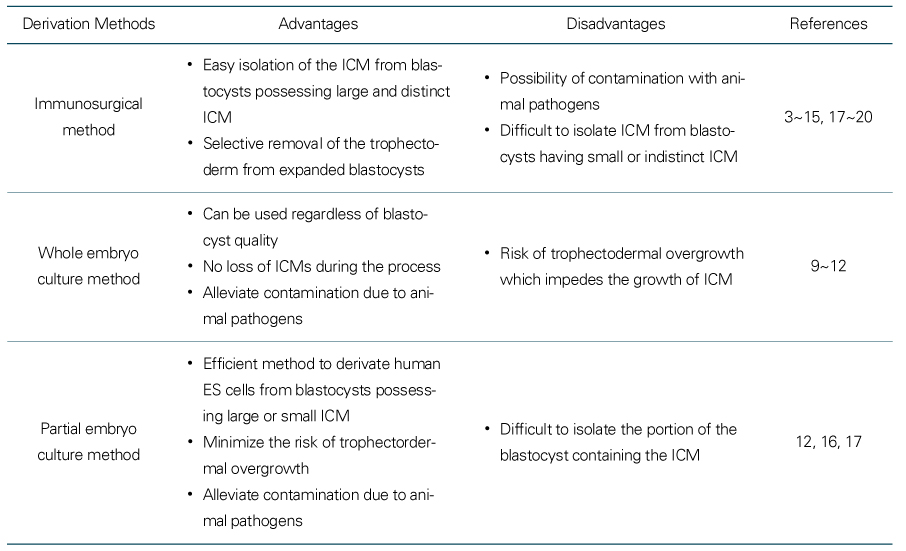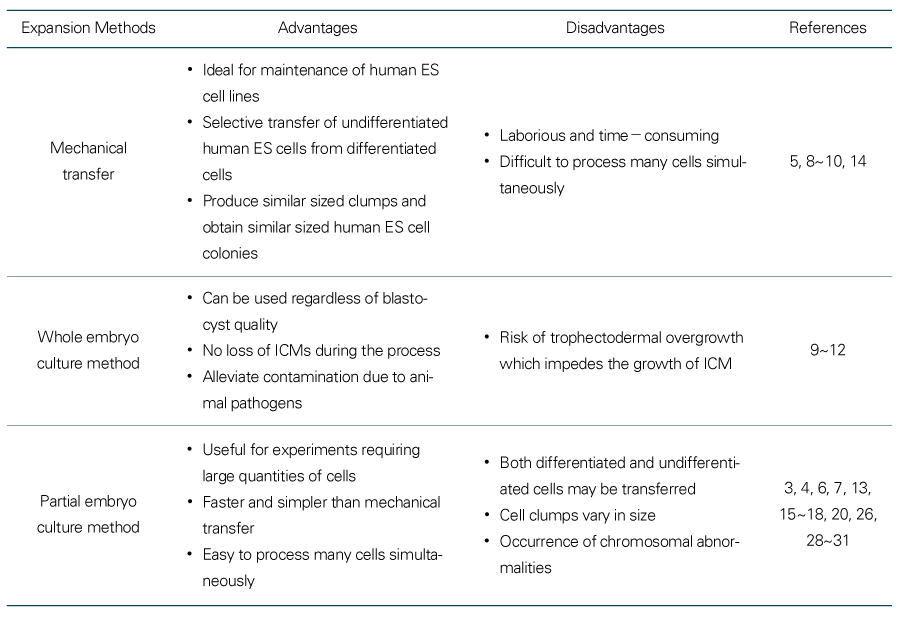 |
 |
- Search
| J Korean Med Assoc > Volume 48(10); 2005 > Article |
Abstract
Stem cells are the body's master cells and have the ability to produce all manner of tissues. Embryonic stem(ES) cells, derived from the inner cell mass(ICM) of the mammalian blastocyst, can continuously proliferate in an undifferentiated state and differentiate into a desired cell lineage under certain conditions. These abilities make ES cells an appealing source for cell replacement therapies, the study of developmental biology, and drug/ toxin screening studies. Compared to mouse ES cells, human ES cells have only recently been derived and studied. Although there are many differences in properties between mouse and human ES cells, the study of mouse ES cells has provided important insight into human ES cell research. In this review, I describe the advantages and disadvantages of methods used for human ES cell derivation, the expansion of human ES cells.
References
1. Evans MJ, Kaufman MH. Establishment in culture of pluripotential cells from mouse embryos. Nature 1981;292:154-156.
2. Martin GR. Isolation of a pluripotent cell line from early mouse embryos cultured in medium conditioned by teratocarcinoma stem cells. Proc Natl Acad Sci U S A 1981;78:7634-7638.
3. Thomson JA. Embryonic stem cell lines derived from human blastocysts. Science 1998;282:1145-1147.
4. Reubinoff BE, Pera MF, Fong CY, Trounson A, Bongso A. Embryonic stem cell lines from human blastocysts: somatic differentiation in vitro. Nat Biotechnol 2000;18:399-304.
5. Park JH. Establishment and maintenance of human embryonic stem cells on STO, a permanently growing cell line. Biol Reprod 2003;69:2007-2014.
6. Stojkovic M. Derivation of human embryonic stem cells from day-8 blastocysts recovered after three-step in vitro culture. Stem Cells 2004;22:790-797.
7. Cowan CA, et al. Derivation of embryonic stem-cell lines from human blastocysts. N Engl J Med 2004;350:1353-1356.
8. Hwang WS, et al. Evidence of a pluripotent human embryonic stem cell line derived from a cloned blastocyst. Science 2004;303:1669-1674.
9. Oh SK, et al. Derivation and characterization of new human embryonic stem cell lines, SNUhES1, SNUhES2, and SNUh-ES3. Stem Cells 2005;23:211-219.
10. Hwang WS, et al. Patient-specific embryonic stem cells derived from human SCNT blastocysts. Science 2005;308:1777-1783.
11. Heins N, et al. Derivation, characterization, and differentiation of human embryonic stem cells. Stem Cells 2004;22:367-376.
12. Kim HS, et al. Methods for Derivation of Human Embryonic Stem Cell. Stem Cells Express, published online July 28, 2005. doi: 10.1634/stemcells.2004-0296
13. Hovatta O, et al. A culture system using human foreskin fibroblasts as feeder cells allows production of human embryonic stem cells. Hum Reprod 2003;18:1404-1409.
14. Inzunza J, et al. Derivation of human embryonic stem cell lines in serum replacement medium using postnatal human fibroblasts as feeder cells. Stem Cells 2005;23:544-549.
15. Park SP, et al. Establishment of human embryonic stem cell lines from frozen-thawed blastocysts using STO cell feeder layers. Hum Reprod 2004;19:676-684.
16. Baharvand H, Ashtiani SK, Valojerdi MR, Shahverdi A, Taee A, Sabour D. Establishment and in vitro differentiation of a new embryonic stem cell line from human blastocyst. Differentiation 2004;72:224-229.
17. Amit M, Itskovitz-Eldor J. Derivation and spontaneous differentiation of human embryonic stem cells. J Anat 2002;200:225-232.
18. Richards M, Fong CY, Chan WK, Wong PC, Bongso A. Human feeders support prolonged undifferentiated growth of human inner cell masses and embryonic stem cells. Nat Biotechnol 2002;20:933-936.
19. Lee JB, et al. Establishment and maintenance of human embryonic stem cell lines on human feeder cells derived from uterine endometrium under serum-free condition. Biol Reprod 2005;72:42-49.
20. Klimanskaya I, Chung Y, Meisner L, Johnson J, Wes MD, Lanza R. Human embryonic stem cells derived without feeder cells. Lancet 2005;365:1636-1641.
21. Solter D, Knowles BB. Immunosurgery of mouse blastocyst. Proc Natl Acad Sci U S A 1975;72:5099-5102.
22. Pickering SJ, et al. Preimplantation genetic diagnosis as a novel source of embryos for stem cell research. Reprod Biomed Online 2003;7:353-364.
23. Smith AG, et al. Inhibition of pluripotential embryonic stem cell differentiation by purified polypeptides. Nature 1988;336:688-690.
24. Williams RL, et al. Myeloid leukaemia inhibitory factor maintains the developmental potential of embryonic stem cells. Nature 1988;336:684-687.
25. James D, Levine AJ, Besser D, Hemmati-Brivanlou A. TGF-beta/activin/nodal signaling is necessary for the maintenance of pluripotency in human embryonic stem cells. Development 2005;132:1273-1282.
26. Xu RH, Peck RM, Li DS, Feng X, Ludwig T, Thomson JA. Basic FGF and suppression of BMP signaling sustain undifferentiated proliferation of human ES cells. Nat Methods 2005;2:185-190.
27. Martin MJ, Muotri A, Gage F, Varki A. Human embryonic stem cells express an immunogenic nonhuman sialic acid. Nat Med 2005;11:228-223.
28. Xu C, et al. Feeder-free growth of undifferentiated human embryonic stem cells. Nat Biotechnol 2001;19:971-974.
29. Amit M, Shariki C, Margulets V, Itskovitz-Eldor J. Feeder layer-and serum-free culture of human embryonic stem cells. Biol Reprod 2004;70:837-845.
30. Carpenter MK, et al. Properties of four human embryonic stem cell lines maintained in a feeder-free culture system. Dev Dyn 2004;229:243-258.
31. Rosler ES, et al. Long-term culture of human embryonic stem cells in feeder-free conditions. Dev Dyn 2004;229:259-274.
32. Amit M, et al. Human feeder layers for human embryonic stem cells. Biol Reprod 2003;68:2150-2156.
33. Oh SK, et al. Methods for expansion of human embryonic stem cells. Stem Cells 2005;23:605-609.
34. Brimble SN, et al. Karyotypic stability, genotyping, differentiation, feeder-free maintenance, and gene expression sampling in three human embryonic stem cell lines. Stem Cells Dev 2004;13:585-597.
35. Inzunza J, et al. Comparative genomic hybridization and karyotyping of human embryonic stem cells reveals the occurrence of an isodicentric X chromosome after long-term cultivation. Mol Hum Reprod 2004;10:461-466.
36. Draper JS, et al. Recurrent gain of chromosomes 17q and 12 in cultured human embryonic stem cells. Nat Biotechnol 2004;22:53-54.
37. Buzzard JJ, Gough NM, Crook JM, Colman A. Karyotype of human ES cells during extended culture. Nat Biotechnol 2004;22:381-382.
38. Mitalipova MM, et al. Preserving the genetic integrity of human embryonic stem-cells. Nat Biotechnol 2005;23:19-20.
- TOOLS
-
METRICS

-
- 0 Crossref
- Scopus
- 1,015 View
- 2 Download
-
Related articles in
J Korean Med Assoc -
Recent Advances in Human Embryonic Stem Cell Research2004 October;47(10)
Clinical application of human embryonic stem cells2011 May;54(5)







